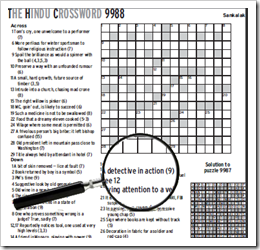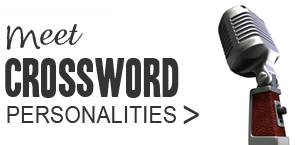| Guest author Chaturvasi aka Rishi, an experienced puzzle creator and blogger, provides tips to new setters on how to check a crossword before sending it for publication. |
 Crossword setters are often aghast when a slight mistake in their work is pointed out by solvers in blogs. It might be that the anagram indicator or homophone indicator is missing or one of the components in the word breakup is not accounted for in wordplay (or subsidiary indication) for the clue. I don't think any setter in India has the luxury of a pre-publication or test solver. So the onus of checking a set crossword rests entirely on the crossword writer. The following is an attempt on a course to follow in this task.
Crossword setters are often aghast when a slight mistake in their work is pointed out by solvers in blogs. It might be that the anagram indicator or homophone indicator is missing or one of the components in the word breakup is not accounted for in wordplay (or subsidiary indication) for the clue. I don't think any setter in India has the luxury of a pre-publication or test solver. So the onus of checking a set crossword rests entirely on the crossword writer. The following is an attempt on a course to follow in this task.
If you have used a software application to produce the crossword and are going to send the file by electronic means, you would do well to take a printout and spend some minutes in checking your work by holding it in your hands. These apps are wonderful and relieve the setter from some routine chores but they cannot be so perfect that no human intervention is needed. On the monitor the document will always look fine with no scratches, no carets, no whorls, no rewrites, no query marks in the margin, but take a hard copy, hold it in your hands and read it and you might discover some mistakes here or there.
Here are some tips to follow in checking a prepared crossword. I may be pardoned if some of these sound elementary but basics matter.
First, are the clues in place? You might know that such-and-such a grid has so many slots and so many clues have to be there. Count and see. If a software app has been used and its clue editor deployed while writing the clues, every clue will be there but this article also keeps in mind those who don't use any apps. Some of you might have prepared templates for your often-used grids and so you might have had all the clue-numbers on paper before you wrote your clues; but if such a template had not been used and if you look at the grid, jot down the clue numbers as you go along and writes the clues, there are chances of your skipping one.
Second, are the clue slots in the grid numbered correctly? If the grid was prepared with crossword software, the numbering will be all right. But if it was done by hand, unless you were too careful, a cell that is hedged in by blocks on three sides or a cell that is not enclosed by any block at all is likely to have been missed. (See related article: how to number the slots)
Third, are the numbers at the end of clues in place? Even crosswords submitted for publication sometimes have enumerations (those numbers within brackets at the end of clues indicating the length) missing. In your template for a grid, you might not have entered the enumerations as these differ from one gridfill to another in slots where multiple-word lights or hyphened words are entered. So while checking the clue sheet you have to look at each light in the solution grid and then at the relevant clue to see if the length is correctly shown.
Fourth, do these enumerations indicate multiple words correctly? Crossword apps automatically supply enumerations in the clue editor but a studied check is necessary. For, if the multiple word phrase is not in its database, it might only show, say, (15) instead of, say, (3,6,2,4) which your light might require. (Of course, the app might allow you to change this manually in its clue editor but the mistake will remain if you had forgotten to do this.)
Fifth, have you checked the breakup for each wordplay component? You have to read each clue and on the margin write the intended breakup. If you do this, you can catch a missing component. (I am aware that crossword app allows one to enter the word breakup in a text box and save it but then how many of us are eager to do more typing work than necessary and how many of us would be using the same clue over and again by creating the clue database?). At this stage you can also ensure that your homophone works by looking up Received Pronunciation in a standard dictionary or even putting the words through a text-to-speech software.
Sixth, are the anagrams perfect? Sometimes in an anagram clue there may be redundancy or insufficiency in the anagram fodder (unless you've used an anagram creator which will take care of the equation). If you created the anagram out of the top of your head, don't trust your eye while checking anagrams. It is useful to write the letters of the anagram fodder on paper and score out those of the anagram to ensure perfection.
Seventh, have you revised the clues separately? Some of these checks must be done separately. That is, if you do the required checks all at once for each clue, while checking subsequent clues it is possible you forget one or the other. It is wise to check all clue numbers in one go, all enumerations in another. The word breakup study can be done clue by clue.
As one who sets puzzles from 1970s, I learnt this by experience. Years later, I smiled when I read in Don Manley’s Chambers Crossword Manual:
When you check your puzzle, check one thing at a time ... You can easily make mistakes by trying to check everything at once.
If you've any tip other than what I have written, share it with us!
Related Posts:
If you wish to keep track of further articles on Crossword Unclued, you can subscribe to it in a reader via RSS Feed. You can also subscribe by email and have articles delivered to your inbox, or follow me on twitter to get notified of new links.






5 comments
Excellent, Rishi
May I suggest an additional way of avoiding error?
Find and cultivate a fellow crossword addict (or more if you can). Send your puzzles to him/her several days prior to publication and have a new pair of eyes to do the checking as well. Few of us are good at seeing our own errors. If it were so we would not see so many elementary spelling errors in advertising signs etc., let alone miscounts in anagrams and crossword clues
Roylow is absolutely spot on.
For every word of Rishi's sage advice is another sentence - get someone else to test solve; and it's precisely for the reason roylow gives. It doesn't matter how often you peruse your own work, a test solver is likely to highlight something you missed or (even more likely) a clue or balance of clues that doesn't work for the solver.
A vital thing for any setter to remember is that the more you read one of your own clues the easier it will appear to be. Too often, familiarity breeds blindness to how difficult a clue can be to someone who hasn't seen it before.
One slip that I've come across sometimes is the omission of "special instructions", such as a description of the crossword's theme missing from the online version, or a mix-up with unusual clues like this one from FT:
Eh? (6)
The answer was supposed to be BEHOLD [EH in BOLD]. It would've been a great clue if only "Eh" was printed in bold, which didn't happen in the final version.
I'm not sure at what stage such errors creep in...could they possibly be reduced if the setter communicates special instructions to the printing people with extra emphasis?
I can speak from experience.
When some such peculiarity is needed while printing a clue, I do write a note on my clue sheet (I use a commercial software to create my puzzles but submit work as a Word document as required) but there is no guarantee that the printed version will be as desired.
Once, several years ago, a particular clue required to be printed in 'all caps'. The instruction, I knew, was followed to the letter by a subeditor who left at the end of his duty. But, the next day it was as usual! How? Later, the proof must have gone to a person in a higher position for a onceover; this person, who may not have had the 'copy' with him and who didn't try to find why the clue was typeset as it was, got it rendered in u/l.c. making utter nonsense of the creation.
In interactive versions, I think, it is not possible to italicise or bolden any words. Some papers give a pointer in a preamble.
BTW, if we make any last-minute change prior to publication, it's always advisable to spell out any word that may cause homophone confusion (e.g., great/grate).
Once I took care (on revision) to send an email with the revised clue that required to begin with an asterisk. When it was published the next day, the star was missing! The sub must have thought it was an intrusive character.
The lesson is: if despite all your efforts, a mistake happens, take it easy! Clever solvers will know!
Post a Comment